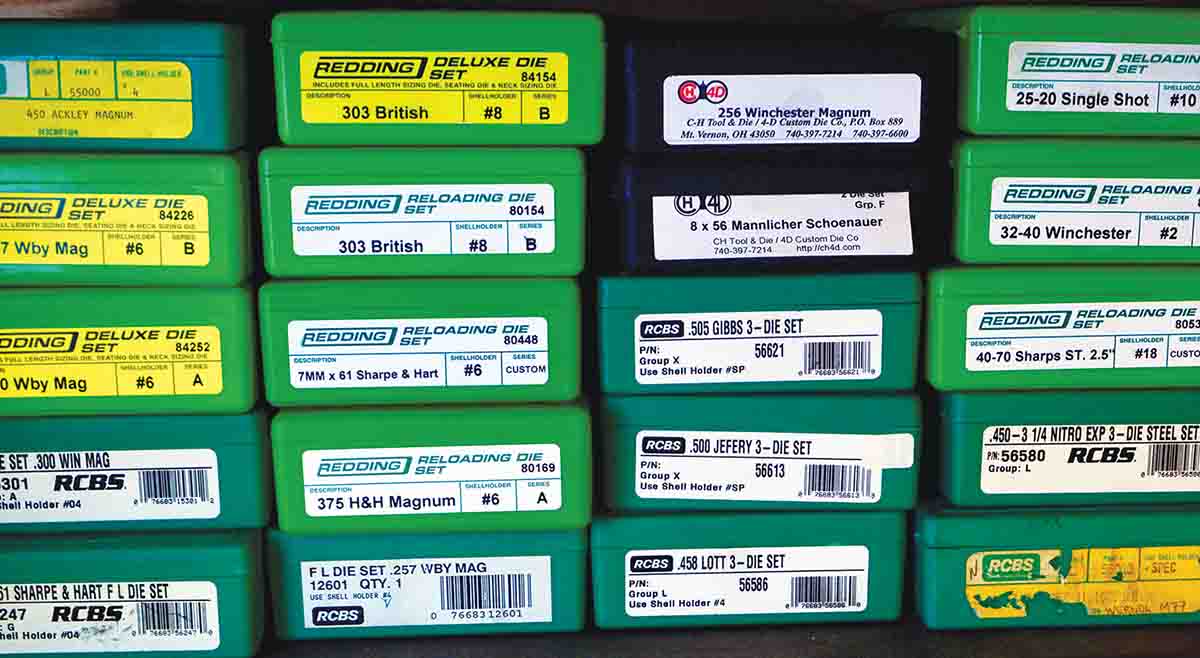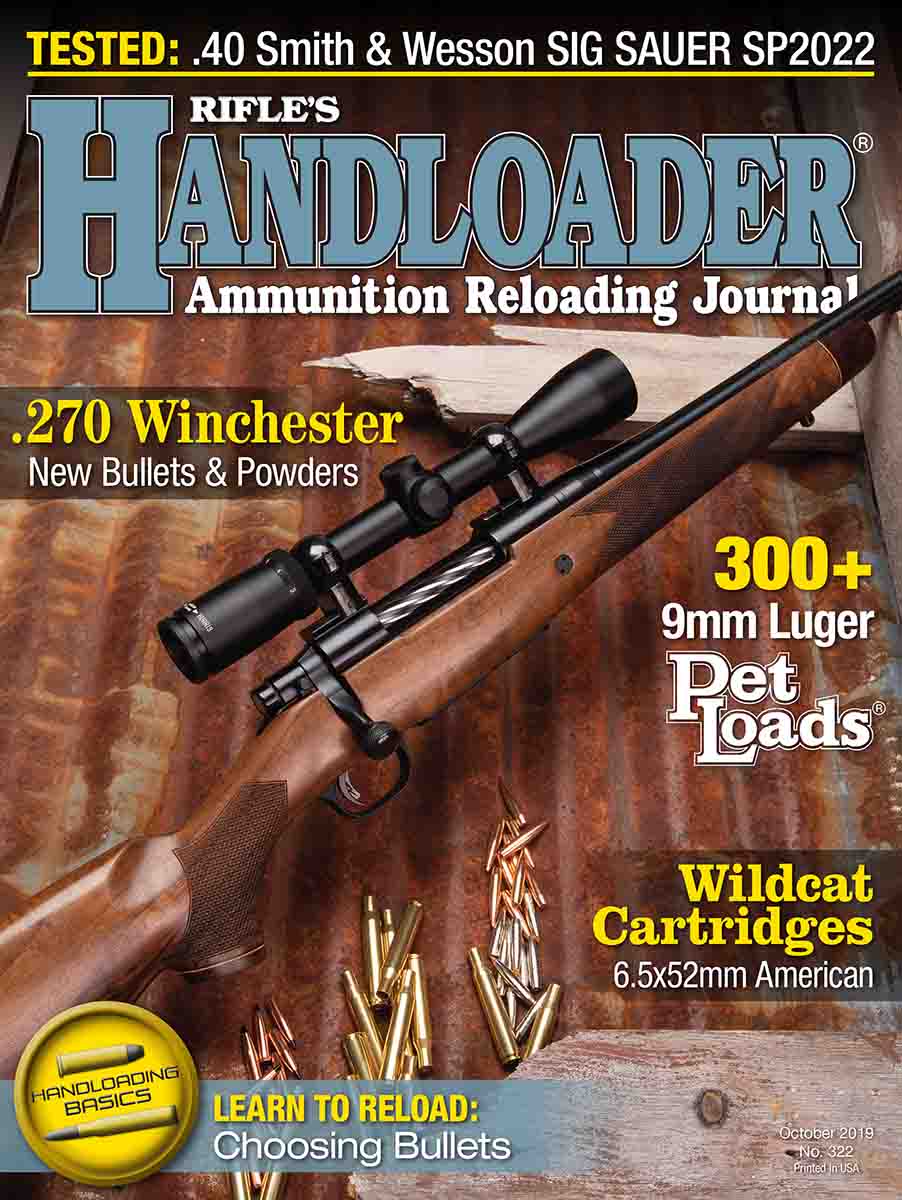In Range
The Science of Innovation
column By: Terry Wieland | October, 19
There are a lot of gadget-mad people around. Fly fishermen spring to mind. Golfers, of course. The average trapshooter is even worse than the average golfer, but at least his passion is relatively sane. Finally, we come to handloaders.
Flip through some old loading manuals and look at the pictures of guys like Dean Grennell or Bob Forker. Invariably, on the bench behind them there is not a single square inch of horizontal surface not occupied by either boxes of bullets or unidentifiable bits and pieces of machinery. In Grennell’s case, bullets are stacked precariously to the ceiling. Like an old-time hoarder that kept narrow aisles through his house navigable between the stacks of bundled newspapers, a handloader’s bench is a trap for the unwary.
The battle to keep enough of one’s bench clean and ready to work is never-ending. This is less the result of an insatiable hunger for gadgets than it is a natural and understandable reluctance to ever throw anything away. You just never know when something might become useful for some as-yet unidentified purpose.
One of the most prolific sources of anonymous bits and pieces is the arcane tools purchased to do something like neck expanding. These always come with four or five interchangeable spuds or cherries, and the ones a handloader has no immediate use for are tucked away, along with the instructions. Then someone borrows the tool, doesn’t return it, and years later you come across the unused accoutrements in the back of a drawer. There are rarely any identifying marks on them, mice have eaten the instructions and the company is long out of business. Do you throw these out? Of course not! You just never know…

I just walked through my office-cum-loading-room and did a rough count. There are about 85 sets of loading dies, which is vastly more calibers than I have guns to load for. Some were acquired years ago for a long-forgotten gun; others were given to me; a few I bought off the “For Sale – Cheap” table at some gun club or other. For some reason, when I see a set of dies in good shape, I tend to buy them unless I already have three sets in that caliber. By the same token, once I have them, I rarely part with them.
This is partly practical. Just because I sold my .40-65 Winchester does not mean I might not own another in the future. Of course, it can be argued (and often is) that already having the wherewithal to load .40-65 makes you that much more likely to buy another one – to buy yet another rifle “you don’t need.” Need? As we all know, need has nothing to do with it.
I’ve solved many knotty loading problems using parts from old die sets. For example, a couple of months ago I acquired an ancient German Schützen rifle in a completely unidentified caliber. There are no markings on the barrel
to say what it is. The bore, what you could see of it through the grime, measured about .44 caliber, or 11mm and a bit. A chamber cast was helpful. The case seemed to resemble that of the .43 Mauser. Unfortunately, the chamber melded invisibly into the throat, giving no indication of the case length.
I rounded up some .43 Mauser cases, cut them down by about .25 inch, then shaved another .10 inch to make them exactly 2 inches long. These chambered readily enough. I was now faced with the problem of loading and shooting three of them in order to get fired cases to send to Redding so it could make custom dies.
This is a chicken-and-egg situation: How do you fashion ammunition to get fired cases when you don’t have dies to load it? I had to repair, bevel and size the case mouths; seat primers; find a reasonable load when I didn’t know whether it was intended for black powder or smokeless; find bullets that would fit; and finally, seat the bullets and iron out the case mouths – all without dies.
Desperation is the mother-in-law of invention. To return the ravaged case mouths to round, I used an expanding bell from a set of .44 Magnum dies, tapped in gently so it would not get stuck. I then trimmed the cases to exact length and beveled and chamfered them. The .43 Mauser case has a strange convex base that fits no standard shell holder, so to prime the cases I used a vise. First, I had to tap the case down onto the primer to get it started. Using the vise alone, the first case mouth buckled, so I took a decapping rod from an old set of dies, removed the pin, and used it to push directly on the web, keeping the case mouth safely away from the vise jaws.
Bob Hayley supplied some .44-caliber 370-grain hollowbase bullets that fit the bore quite well. These seated part way with finger pressure, then were pressed down with a .45 ACP seating die. The slight bell was ironed out using another die, the mouth of which was happily the same size as the case mouth.
Altogether, I used bits from five different sets of loading dies, two of which were for calibers I no longer own. In the end, I had three rounds that chambered perfectly, fired without incident and provided the necessary three expanded cases to send to Redding.
That company sent me a three-die set, along with two bullet seaters of different lengths and a custom shell holder to accommodate the odd Mauser base. I am now equipped to handle anything based on the .43 Mauser case but, to be honest, I am not out searching for more. One is quite enough for now. However, there are more than a few such Schützen rifles floating around, and in unidentified calibers they often sell for a pittance. I’m ruling nothing out.
Thinking back, starting from the very first handloading room I ever walked into at the age of 16, every single one has been, to the uninitiated eye, a random aggregation of equipment, bits, pieces and gadgets of no recognizable use. Yet every guy who was blessed with such a room seemed to know where everything could be found, and could size up how to solve a thorny problem almost at a glance – or at least know where to start. It’s a gift, I’m sure, and one not shared by fly fishermen or golfers.


